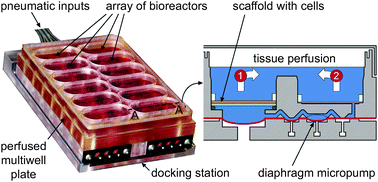Perfused multiwell plate for 3D liver tissue engineering†
Abstract
In vitro models that capture the complexity of in vivo tissue and organ behaviors in a scalable and easy-to-use format are desirable for

* Corresponding authors
a
Department of Biological Engineering, Massachusetts Institute of Technology, Cambridge, MA, USA
E-mail:
griff@mit.edu
b Department of Mechanical Engineering, Massachusetts Institute of Technology, Cambridge, MA, USA
c Department of Chemical Engineering and Biotechnology, University of Cambridge, Cambridge, UK
In vitro models that capture the complexity of in vivo tissue and organ behaviors in a scalable and easy-to-use format are desirable for

 Please wait while we load your content...
Something went wrong. Try again?
Please wait while we load your content...
Something went wrong. Try again?
K. Domansky, W. Inman, J. Serdy, A. Dash, M. H. M. Lim and L. G. Griffith, Lab Chip, 2010, 10, 51 DOI: 10.1039/B913221J
To request permission to reproduce material from this article, please go to the Copyright Clearance Center request page.
If you are an author contributing to an RSC publication, you do not need to request permission provided correct acknowledgement is given.
If you are the author of this article, you do not need to request permission to reproduce figures and diagrams provided correct acknowledgement is given. If you want to reproduce the whole article in a third-party publication (excluding your thesis/dissertation for which permission is not required) please go to the Copyright Clearance Center request page.
Read more about how to correctly acknowledge RSC content.
 Fetching data from CrossRef.
Fetching data from CrossRef.
This may take some time to load.
Loading related content
